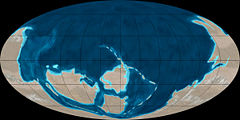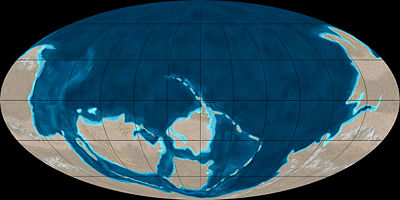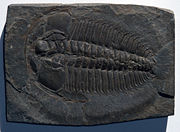Cambrian
2008/9 Schools Wikipedia Selection. Related subjects: Geology and geophysics
| Cambrian period 542 - 488.3 million years ago |
|
 |
|
| Mean atmospheric O2 content over period duration | ca. 12.5 Vol % (63 % of modern level) |
| Mean atmospheric CO2 content over period duration | ca. 4500 ppm (16 times pre-industrial level) |
| Mean surface temperature over period duration | ca. 21 °C (7 °C above modern level) |
|
Key events in the Cambrian
view • discuss •
-545 —
–
-540 —
–
-535 —
–
-530 —
–
-525 —
–
-520 —
–
-515 —
–
-510 —
–
-505 —
–
-500 —
–
-495 —
–
-490 —
–
←
Orsten Fauna
←
Burgess Shale
←
Sirius Passet Fauna
←
Chengjiang Fauna
←
First Trilobites
←
First Arthropod trace fossils
a m b r i a n ←
and Echinoderms
Neoproterozoic
An approximate timescale of key Cambrian events.
The Cambrian explosion took place during the lower Cambrian, but its duration is poorly defined. Axis scale: millions of years ago. |
|
The Cambrian is a geologic period and system that began about 542± 0.3 Ma (million years ago) at the end of the Proterozoic eon and ended about 488.3± 1.7 Ma with the beginning of the Ordovician period ( ICS, 2004). It was the first period of the Paleozoic era of the Phanerozoic eon. The Cambrian takes its name from Cambria, the classical name for Wales, the area where rocks from this time period were first studied.
The Cambrian is the earliest period in whose rocks are found numerous large, distinctly fossilizable multicellular organisms. This sudden appearance of hard body fossils is referred to as the Cambrian explosion. Despite the long recognition of its distinction from younger Ordovician rocks and older Precambrian rocks it was not until 1994 that this time period was internationally ratified. The base of the Cambrian is defined on a complex assemblage of trace fossils known as the Trichophycus pedum assemblage. This assemblage is distinct from anything in the Precambrian as it has ecologically tiered vertical burrows which are absent from the Precambrian.
Cambrian subdivisions
The Cambrian period follows the Ediacaran and is followed by the Ordovician period. The Cambrian is divided into three epochs — the Early Cambrian (Caerfai or Waucoban), Middle Cambrian (St Davids or Albertian) and Furongian (also known as Late Cambrian, Merioneth or Croixan). Rocks of these epochs are referred to as belonging to the Lower, Middle, or Upper Cambrian.
Each of the epochs are divided into several stages. Only one, the Paibian, has been recognized by the International Commission on Stratigraphy, and others are still unnamed. However, the Cambrian is divided into several regional faunal stages of which the Russian-Kazakhian system is most used in international parlance:
| Chinese | North American | Russian-Kazakhian | Australian | Regional | |
|---|---|---|---|---|---|
| Furongian | Ibexian (part) | Ayusokkanian | Idamean | Dolgellian | |
| Sunwaptan | Sakian | Mindyallan | Festiniogian | ||
| Steptoan | Aksayan | Payntonian | Maentwrogian | ||
| Marjuman | Batyrbayan | ||||
| Middle Cambrian | Maozhangian | Mayan | Boomerangian | ||
| Zuzhuangian | Delamaran | Amgan | Undillian | ||
| Zhungxian | Florian | ||||
| Templetonian | |||||
| Dyeran | Ordian | ||||
| Early Cambrian | Longwangmioan | Toyonian | Lenian | ||
| Changlangpuan | Montezuman | Botomian | |||
| Qungzusian | Atdabanian | ||||
| Meishuchuan | Tommotian | ||||
| Nemakit-Daldynian |
Cambrian dating
The time range for the Cambrian has classically been thought to have been from about 500 mya to about 570 mya. The lower boundary of the Cambrian was traditionally set at the earliest appearance of early arthropods known as trilobites and also unusual forms known as archeocyathids (literally 'ancient cup') that are thought to be the earliest sponges and also the first non-microbial reef builders.
The end of the period was eventually set at a fairly definite faunal change now identified as an extinction event. Fossil discoveries and radiometric dating in the last quarter of the 20th century have called these dates into question. Date inconsistencies as large as 20 Ma are common between authors. Framing dates of ca. () 545 to 490 mya were proposed by the International Subcommission on Global Stratigraphy as recently as 2002.
A radiometric date from New Brunswick puts the end of the first stage of the Cambrian around 511 mya. This leaves 21 Ma for the other two stages of the Cambrian.
A more precise date of 542 ± 0.3 mya for the extinction event at the beginning of the Cambrian has recently been submitted. The rationale for this precise dating is interesting in itself as an example of paleological deductive reasoning. Exactly at the Cambrian boundary there is a marked fall in the abundance of carbon-13, a "reverse spike" that paleontologists call an excursion. It is so widespread that it is the best indicator of the position of the Precambrian-Cambrian boundary in stratigraphic sequences of roughly this age. One of the places that this well-established carbon-13 excursion occurs is in Oman. Amthor (2003) describes evidence from Oman that indicates the carbon-isotope excursion relates to a mass extinction: the disappearance of distinctive fossils from the Precambrian coincides exactly with the carbon-13 anomaly. Fortunately, in the Oman sequence, so too does a volcanic ash horizon from which zircons provide a very precise age of 542 ± 0.3 Ma (calculated on the decay rate of uranium to lead). This new and precise date tallies with the less precise dates for the carbon-13 anomaly, derived from sequences in Siberia and Namibia. It is presented here as likely to become accepted as the definitive age for the start of the Phanerozoic eon, and thus the start of the Paleozoic era and the Cambrian period.
Geography
Cambrian continents are thought to have resulted from the breakup of a Neoproterozoic supercontinent called Pannotia. The waters of the Cambrian period appear to have been widespread and shallow. Gondwana remained the largest supercontinent after the breakup of Pannotia. It is thought that Cambrian climates were significantly warmer than those of preceding times that experienced extensive ice ages discussed as the Varanger glaciation. Also there was no glaciation at the poles. Continental drift rates in the Cambrian may have been anomalously high. Laurentia, Baltica and Siberia remained independent continents since the break-up of the supercontinent of Pannotia. Gondwana started to drift towards the South Pole. Panthalassa covered most of the southern hemisphere, and minor oceans included the Proto-Tethys Ocean, Iapetus Ocean, and Khanty Ocean, all of which expanded by this time.
Fauna
The Cambrian marked a step change in the the diversity and composition of Earth's biosphere. The incumbent Ediacaran biota suffered a mass extinction at the base of the period, which corresponds to an increase in the abundance and complexity of burrowing behaviour. This behaviour had a profound and irreversible effect on the substrate, and occurred around the same time as the Cambrian explosion saw the seemingly rapid appearance of representatives of all but one of the modern phyla. There are even suggestions that some Cambrian organisms ventured onto land, producing the trace fossils Protichnites and Climactichnites.
Many modes of preservation are unique to the Cambrian period, resulting in an unusually high proportion of lagerstatte:
Flora
Generally it is accepted that there were no land plants at this time, although it is likely that a microbial "scum" comprising fungi, algae and possibly lichens covered the land.


